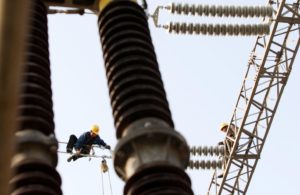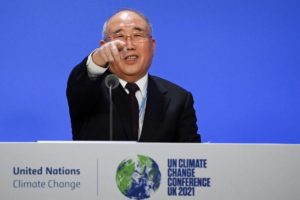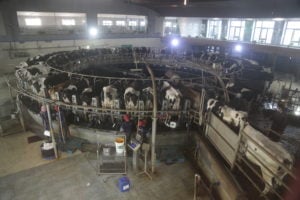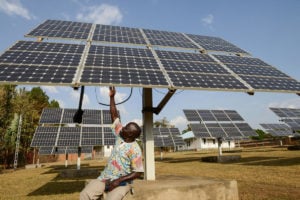A declaration made by China and the US at the COP26 climate summit has pushed methane into the limelight. Both countries have acknowledged the significant impact of emissions of the gas on rising global temperatures.
The US–China Joint Glasgow Declaration on Enhancing Climate Action in the 2020s, published last November, commits both countries to working together to bolster monitoring, management and research of methane emissions over the next ten years. China said it will produce a comprehensive and forceful national plan to control and reduce emissions, while the US had already announced its own emission-cutting action plan.
The latest official figures available show China released 55.3 million tonnes of methane in 2014. When converted to CO2 equivalent, that is 10.4% of the country’s total greenhouse gas emissions, second only to CO2 itself (81.6%). The gas has a shorter “lifespan” in the atmosphere – about 12 years, compared to over 100 years for CO2. But methane’s warming potential (the ability to trap heat in the atmosphere) is 80 times that of CO2 over 20 years. Controls will therefore help to reduce near-term warming.
Last May, the Climate and Clean Air Coalition and UNEP (the United Nations Environment Programme) released a Global Methane Assessment, finding effective measures could cut anthropogenic methane emissions by 45% in the next 10 years. That would reduce the level of warming reached in 2045 by almost 0.3C. It might not sound like much, but global average temperature has already risen 1.3C since the Industrial Revolution. Avoiding 0.3C of warming could therefore see the world stay within the Paris Agreement’s preferred warming limit of 1.5C.
In the past, far less attention has been paid to methane than to carbon dioxide. But methane controls will be a powerful tool for limiting warming. According to the US–China Joint Glasgow Declaration, China is to take a range of actions to cut methane emissions, both by building a system for monitoring, measuring, reporting and verifying emissions, and by developing policies, technologies and standards.
The life and times of methane
Methane featured surprisingly heavily in the joint declaration.
In the run-up to COP26, the US and EU issued a Global Methane Pledge, with another 108 countries signing up during COP26, committing to reduce anthropogenic methane emissions by 30% by 2030 on a 2020 baseline. China did not join.
Methane, however, accounted for a sixth of the length of the joint declaration with the US, concluded in the latter half of the COP26 talks. This demonstrates China’s determination to control methane emissions. The schedule set out in the declaration is clear: by this year’s COP27 the two parties will “develop additional measures to enhance methane emission control, at both the national and sub-national levels”. And China, in addition to its newly submitted NDC, “intends to develop a comprehensive and ambitious National Action Plan on methane, aiming to achieve a significant effect on methane emissions control and reductions in the 2020s.”
China’s circumstances drove the decision to not sign up to the Global Methane Pledge but to commit to action on methane in the joint declaration, experts told China Dialogue. Teng Fei, deputy director of the Institute of Energy, Environment and Economy at Tsinghua University, points out that methane emissions in the US and EU are concentrated in the oil and gas sector, whereas China’s come mainly from coal mining. Tackling methane emissions from coal mines is harder and more costly, and the potential for reductions is less.
The targets proposed by the EU and the US are easier for them to achieve than for China. I think that’s the reason China didn’t sign up.Teng Fei, Institute of Energy, Environment and Economy at Tsinghua University
“Given the differences in the make-up of methane emissions and ease of reduction, the targets proposed by the EU and the US are easier for them to achieve than for China. I think that’s the reason China didn’t sign up to the Global Methane Pledge.” Teng Fei told China Dialogue.
“But China is already aware of the potential of reducing methane emissions, and its importance to mitigating climate change,” he added. “Now is the time to make realistic commitments, setting targets appropriate for China. That approach was the ‘greatest common factor’ that the two countries found in their joint declaration.”
Meanwhile, Ministry of Foreign Affairs spokesperson Wang Wenbin said at a press conference that developing nations commonly lack the basic data, monitoring technology and effective measures needed for controls of non-CO2 greenhouse gases, and that needs to be remembered when setting ambitious targets.
Given China’s stance on controls of non-CO2 greenhouse gases in recent years, the prominence of methane in the US–China Joint Glasgow Declaration could have been predicted.
In 2016, “Controlling non-CO2 greenhouse gases” was included in the the 13th Five Year Plan (2016-2020) outline. Then, last March, the 14th Five Year Plan (2021-2015) outline went further, saying China would “strengthen controls on other greenhouse gases such as methane, hydrofluorocarbons and carbon tetrafluoride”.
But how will that be done? At a seminar on methane held in March 2021, Li Gao, head of the Ministry of Ecology and Environment’s Department of Climate Change, explained that the 14th Five Year Plan period will see China produce action plans for controlling methane, with new policy, technology and standards introduced in sectors including oil and gas, coal and waste. Market mechanisms will also be used to encourage emissions cuts.
More accurate data needed
A lot of work is still needed on the basics. The priority areas will be monitoring, calculating, reporting and verifying methane emissions in key sectors, such as energy, agriculture and waste.
Globally, methane data is obtained more by calculation than by actual measurement. Sample monitoring is carried out at emission sources, with the data obtained used to calculate average “emission factors”, and then national methane emissions. This is known as bottom-up calculation. Top-down calculations, on the other hand, use satellites, airplanes, drones and vehicles to monitor methane at the country, regional or facility level.
What is an emission factor?
An emission factor characterises the emissions potential of a polluting activity. It is expressed as the weight of an emitted gas divided by the unit weight, volume, distance or duration of the polluting activity that gave rise to it. For example, kilograms of methane emitted per tonne of coal burned. High values are associated with high emissions.
But research shows that neither method is adequate, and there is room to improve the quality and coverage of data.
Between 90% and 95% of China’s methane emissions in the energy sector come from coal mines. For the 2014 National Greenhouse Gas Emissions Inventory, the most recent to be made public, China used default emission factors provided by the IPCC in 1996 to calculate methane emissions from open-air coal mines. To calculate emissions from abandoned mine shafts, China used the IPCC’s simplest methodology and simplified assumptions. But Teng Fei says these factors and methodologies may not be suitable in China – and any inaccuracies will have a big impact on the overall data.
The US may have the same problem. Research between 2012 and 2018, headed up by the Environmental Defense Fund, a US environmental organisation, measured 13 million tonnes of methane emissions throughout the oil and gas industrial chain – 60% higher than the figure calculated by the Environmental Protection Agency using emissions factors. Calculation methods need to be improved globally, with more on-site methane monitoring to make inventories more accurate and support localisation of emission factors.
Teng Fei highlighted abandoned mine shafts: “China has been shutting down small mines, and the number of working shafts has plummeted. The majority are no longer in use. But China doesn’t have a handle on the associated geological and methane emissions data.” He thinks there should be more on-site monitoring and establishment of emission factors suited to China.
There are also limits to “top-down” monitoring. Thick clouds can interfere with spectral imaging by satellites, reducing accuracy. And not all the methane in the atmosphere is from human activity – there are other sources, such as wetlands. “When processing data, researchers need to carefully account for the background concentrations of methane in the atmosphere and sources of interference,” said a Chinese research paper published in 2021.
The research added that both methods have problems. China, along with the rest of the world, needs to combine both approaches, merging the data to obtain a better picture of what is actually happening.
The industrial emissions problem
At a late November press conference, the Ministry of Ecology and Environment’s Department of Climate Change said China will also: research controlling methane emissions; produce an action plan for the gas; encourage trials of methane emission reductions; and increase international cooperation.
Currently, China has few rules on emissions of methane. Those it does have are focused on emissions from urban water-treatment plants. The biggest emitters – coal mines, oil and gas facilities – aren’t subject to any binding standards, although some firms are looking at the problem and carrying out monitoring.
The lack of policy guidance or economic reward means companies aren’t motivated to tackle those emissions.
According to a report in China Energy News last April, the coal industry releases methane during extraction, processing, transportation and consumption, and reducing those emissions will cost. “Companies are unlikely to spend more, unless it’s due to safety concerns or to harness a profitable source of coalbed methane,” the reporter suggested.
It costs companies to recover methane. If there’s neither reward for doing that, nor punishment for failing to, policy targets will be hard to deliver.Teng Fei, Institute of Energy, Environment and Economy at Tsinghua University
There are policies in place encouraging the harvesting of methane gas where its concentration is over 2% by volume, and in particular over 8%. But 80% of emissions are from sources where methane is less than 1%. That’s very hard to make commercial use of, so the gas is allowed to enter the atmosphere. Han Jiaye, head of the Ministry of Emergency Management’s Energy Safety Institute, said in an interview with China Energy News that even demonstration projects for use of methane had been paused because they were uneconomic. “Making use of methane where possible [to incentivise the capture of it] is essential to cutting those emissions.”
China’s methane action plan, announced in the US–China Joint Glasgow Declaration and due by COP27, may help.
Teng Fei thinks China needs to decide whether to use sticks such as binding emissions standards or carrots such as subsidies. “It costs companies to recover methane. If there’s neither reward for doing that, or punishment for failing to, policy targets will be hard to deliver.” He says the government should consider complementary financial measures when setting targets, and strengthen coordination between these carrot and stick policies.
Some oil and gas firms are already acting. In June, China Gas signed up to the UNEP-led Oil and Gas Methane Partnership (OGMP), becoming its first Chinese member. The OGMP aims to help member firms understand and manage their methane emissions and promote information and technology sharing. Other members include 66 big energy firms from around the world, not least Shell, BP and Total. And in May, seven Chinese energy firms, including the China National Petroleum Corporation and Sinopec, formed the China Oil and Gas Methane Alliance, with an aim of reducing methane emissions intensity during natural gas production to below 0.25%. In October, the Hong Kong and China Gas Company headed up ten Chinese coal gas suppliers signing up to a methane initiative, indicating they too are on board with cutting emissions.
As China begins to draw up its plans for methane emissions control for the next decade, such moves by its industries are welcome signs of momentum in acting on this potent greenhouse gas. But the intention to act must now be met with effective implementation to ensure the chances of successful mitigation by 2030 – and the broader warming goals of 2050 – remain alive.









